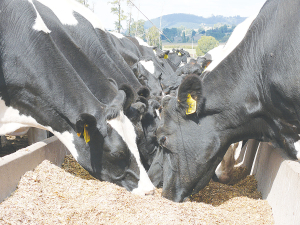Hitting heifer liveweight targets
Early December marks a key transition for many dairy farmers, as weaned replacement heifers head off-farm to grazing.
 There is a lot of maize silage being fed already and with calving starting and the wet continuing, it looks like this level of feeding will continue into the spring.
There is a lot of maize silage being fed already and with calving starting and the wet continuing, it looks like this level of feeding will continue into the spring.
For many North Island farmers, the wet weather just keeps on coming.
There seems be very little respite from rainy days and sodden pastures. Paddocks damaged by cows are common across the island and pasture covers are low on many farms. There is a lot of maize silage being fed already and with calving starting and the wet continuing, it looks like this level of feeding will continue into the spring.
Because of this, I am frequently being asked two questions…. how much maize silage can I feed my cows, and can I feed maize silage to calves?
How much maize can you feed cows?
Interestingly most of the world’s highest producing herds are fed diets based on maize silage and lucerne. In New Zealand, we usually have an abundance of pasture but in springs like this, that is not the case. Maize silage is an excellent feed to manage pastures when wet soils limit pasture growth rates and utilisation.
However, there are a few things to be aware of.
Watch dietary crude protein levels
The high crude protein (above 20%) content of pasture will be diluted by low crude protein (7-8%) maize silage. Taking this into consideration, farmers can still feed quite large amounts of maize silage without compromising milk production. Cows require around 18% crude protein (CP) in early lactation. Assuming a cow is being fed 18 kgDM and pasture protein levels are 24%, a diet of 11 kgDM pasture and 7 kgDM maize silage will provide enough protein. You will need to decrease maize silage feeding rates if the diet contains other low protein feeds (e.g. grain, molasses, tapioca, brassica or fodder beet) or moderate protein feeds (e.g. PKE).
One feedout or two?
Many farmers report that once cows have eaten more than 3-4 kgDM maize silage in a single feed, intakes slow, cows need a lot longer on the feed pad and this reduces grazing time. When soils are wet, this is a great way of reducing pasture damage as it means less time in the paddock. However, increased time on the pad can also increase the chance of sore feet or hips and animal welfare needs to be monitored. Overfilling feed bins can increase the amount of feed being wasted. If you are feeding more than 4 kgDM per feed, consider splitting it in two.
Check mineral levels
Mineral supplementation may be required if you are feeding a significant amount of the diet as maize silage. Use the following table as a guideline for milkers only. If you are feeding more than 40% of the diet as maize silage or something other than just maize silage and pasture, contact your farm advisor, veterinarian or animal nutritionist for a farm specific mineral recommendation.
Let pasture substitution work for you but know when to stop. Substitution often has negative overtones as it has been associated with wasted feed and loss of pasture quality. However, a large feed deficit occurs, substitution can be a positive thing as it helps prevent overgrazing of pasture. The secret is to know when to reduce the maize silage feeding rate to prevent the loss of pasture quality. A simple rule is if cows are consistently leaving residuals of more than 1800 kgDM, reduce the amount of maize silage being fed on the pad.
Can I feed maize silage to my young stock?
The simple answer is yes. Many farmers are feeding maize silage to their young stock and are using it to help achieve target liveweights as laid out by DairyNZ1. These are as follows:
However, it is vital that growing calves are fed enough protein to ensure they meet these target liveweights. Young calves (100- 200kg liveweight) need 17% crude protein, while calves between 200- 300kg require 15% crude protein. Heifers above 350kg need a minimum of 14% crude protein in their diet.
If you want to feed maize silage to your calves, test your pasture to determine its crude protein level and then make sure enough pasture is fed with the maize silage to meet the energy and protein needs of the calf.
In summary, maize silage is an excellent support for pasture based, dairy production systems. It is a great tool to manage pasture cover levels. To get the most out of your maize silage watch crude protein and mineral levels and if you are feeding high rates, feed it twice a day.
Ian Williams is a Pioneer forage specialist. Contact him at This email address is being protected from spambots. You need JavaScript enabled to view it.
1DairyNZ 2023. Facts and Figures - A quick reference guide for New Zealand dairy farmers.
A New Zealand dairy industry leader believes the free trade deal announced with India delivers wins for the sector.
The Coalition Government will need the support of at least one opposition party to ratify the free trade deal with India.
Primary sector leaders have welcomed the announcement of a Free Trade Agreement between India and New Zealand.
At Pāmu’s Kepler Farm in Manapouri, mating has wrapped up at the across-breed Beef Progeny Test.
More than 150 people turned up at Parliament recently to celebrate the 20th anniversary of Horticulture New Zealand (HortNZ).
Biosecurity New Zealand says Kiwis should continue to keep an eye out for yellow-legged hornets (Vespa velutina) over the holiday season.
President Donald Trump’s decision to impose tariffs on imports into the US is doing good things for global trade, according…
Seen a giant cheese roll rolling along Southland’s roads?